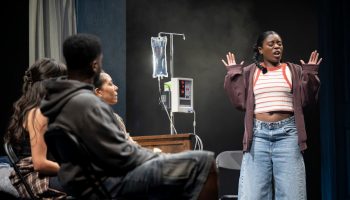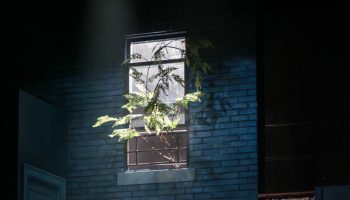Julia Weber
Staff Writer

For Jeanette Oi-Suk Yew, lighting is an imperative piece of the puzzle that brings a play from script to stage.
Yew is the lighting designer for Chautauqua Theater Company’s production of Execution of Justice, which continues its run at 2 p.m. and 7:30 p.m. today in Bratton Theater. The play, written and directed by Emily Mann, follows the trial of former San Francisco city supervisor Dan White, who killed former mayor George Moscone and former city supervisor Harvey Milk, California’s first openly gay elected official.
In Yew’s perspective, lighting design is one of the most abstract of the theatrical disciplines because its subtlety and unobtrusiveness often goes unnoticed. Most people, she said, don’t wake up in the morning and think about how the light is impacting them, because it’s just intrinsically part of their daily lives.
She described lighting design as a secondary art because it is responsive to the environment of the play and the actors’ performances.

Yew begins her work as lighting designer by meeting with others behind the curtain — the playwright and director, the sound designer, the production designer and so forth — to gain a sense of the play’s lighting needs and the creative vision of the director. The early work is gaining an understanding of what the other designers are looking for, so she can establish a vocabulary and choose her tools accordingly.
“I’m actually actively trying to gain vocabulary so that I can be ready when I’m in tech,” Yew said.
Then, she develops a light plot, which she describes as a “tool box” for her to make use of during the design process. By ensuring she has the right equipment, she can work with the designers and director to produce creative effects that elevate the production.
Whereas other disciplines can begin to brainstorm and begin creating work early on, light’s responsiveness to the scene means that Yew is often working in the final stages, setting the lighting to enhance the work already put in place by other designers.
“We can’t really create what the lighting look is going to be until all of the elements are together in real space,” she said. “This is a very different way of thinking in terms of other design disciplines.”
“Lighting is just really not afforded any sort of pre-work, because it is all dependent on the performance in actual space,” she said. “The discovery and the iteration and the ideas — whether the ideas are actually going to work or not in the storytelling sense — doesn’t reveal itself until we are in the tech rehearsal process.”
Yew said the production has many layers of artistic decisions that go into the lighting, stage and sound design, and even while many of these decisions are quite subtle, they take immense precision and attention to detail.
“When people come see the show, they only see the tip of that iceberg, but what’s holding it up is all these other things that come below that, that allow us to then see a piece that seemingly looks very simple and achieves the idea that it achieves — the emotional quality of it,” she said.
“I don’t think about myself as another thing. I think about myself as part of the glue that combines — we make something together. Yes, my specialization is in using lights as the tool, but I look at myself as part of the storytelling team,” she said.
Yew said she was most compelled by the chance to bring a play written decades ago back to the stage for a timely performance.
“I was very compelled by how this piece is so relevant and, to me, (it) seems obvious — but I was really curious, I was really interested: How do we make this relevant for the generation of people who this is nothing more than maybe, at best, an asterisk in their education? That’s the part that is really compelling to me,” Yew said.
Through Execution of Justice, Yew sees theater responding to the culture that surrounds it. While it premiered in 1985, the play is still relevant and provides a lens for viewers to look at the world around them in 2025. For Yew, taking on the challenge of bringing a specific historical moment to the stage in this contemporary way is one she takes quite seriously.
“Can it achieve the thing that, instead of creating something new, using something that happened to then elevate (these issues)?” she asked.




